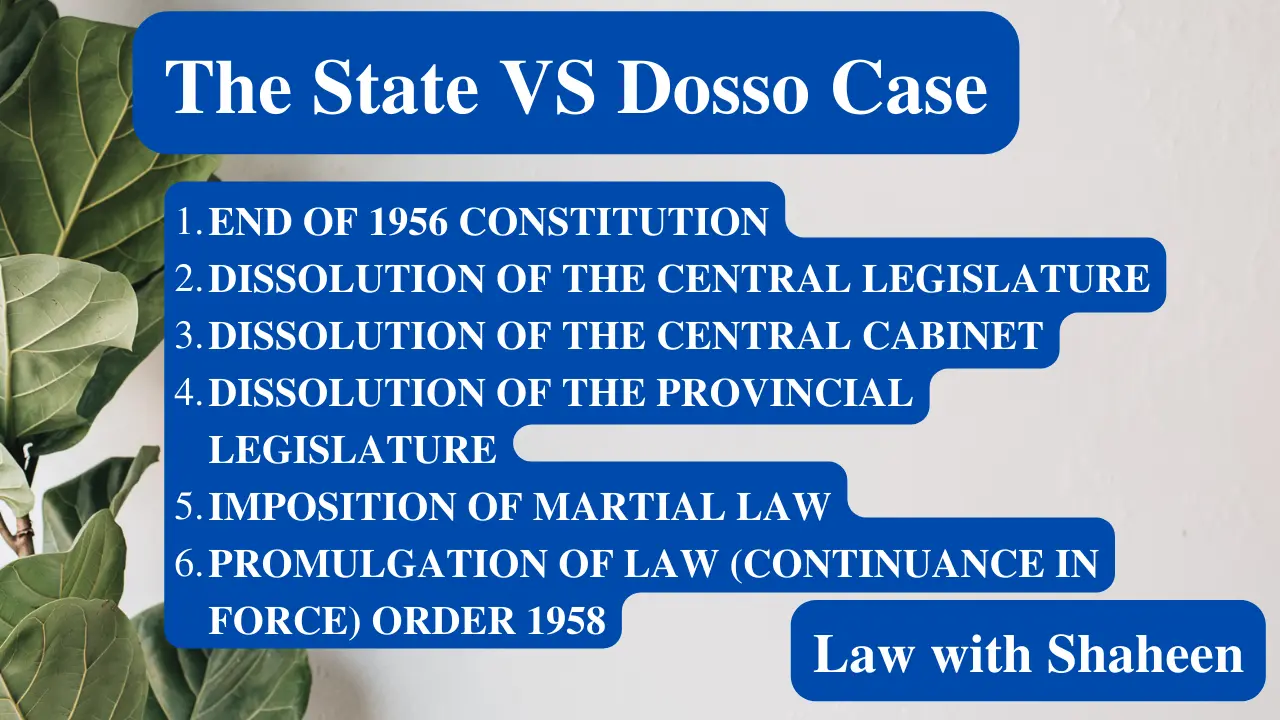Table of Contents
Introduction to The State VS Dosso Case:
The judiciary plays a very important role in the interpretation of statutes and laws. The judiciary has a pivotal role in the development of law. It develops law by giving judgments that become precedents. So, precedents may be regarded as a source of law.
In Pakistan too, the superior Courts gave judgments that became precedents. There have been a lot of important and leading cases in the history of Pakistan. The State VS Dosso case is one of them in which the Chief Justice was Muhammad Munir and the other judges were Ameer ud Din, Shahab-ud-Din, R, Comelius.
Facts of the State Vs Dosso Case:-
Following are the important facts of the State VS Dosso Case:-
1. End of 1956 Constitution:-
A historic event took place in the history of Pakistan in 1958 and the first Constitution, the 1956 Constitution, came to an end. There were several reasons which led to the end of the Constitution which remained operative only for two years.
2. Dissolution of the Central Legislature:-
The 1956 Constitution was annulled and the Central Legislature was dissolved with the announcement that the Parliamentary democracy had proved fruitless.
3. Dissolution of the Central Cabinet:-
With the dissolution of the Central legislature, the life of the Central cabinet also came to an end with its dissolution.
4. Dissolution of the Provincial Legislature:-
Along with the dissolution of the Central legislature and Central Cabinet, the Provincial legislature was also dissolved.
5. Dissolution of the Provincial Cabinet:-
The Martial Law imposers also dissolved the Provincial Cabinet.
6. Imposition of Martial Law:-
The Martial Law was imposed and the Chief of the Army, Muhammad Ayub Khan, took the office of the Chief Martial Law Administrator. According to the plan, Muhammad Ayub Khan had to become the head of the state and the then President, Sikandar Mirza had to leave his office.
7. Control of Legislative Functions by Chief Martial Law Administrator:-
The Chief Martial Law Administrator, Muhammad Ayub, Khan took control of all legislative functions.
8. Control of Administrative Powers by Chief Martial Law Administrator:-
Because of the imposition of Martial Law, The Chief Martial Law Administrator, Muhammad Ayub Khan also took control of the administrative powers of the state and became the real head of the state.
9. Promulgation of Law (Continuance in Force) Order 1958:-
The Chief Martial Law Administrator, Muhammad Ayub Khan after taking control of the legislative and administrative functions, introduced and promulgated the Law (continuance in force) Order 1958.
10. EFFECT OF ORDER Effect of Order:-
The effect of the Law (continuance in force) Order 1958, was the validating of all laws that existed before the imposition of Martial Law. The other effect was the taking control of all legislative and administrative functions by the Chief Martial Law Administrator, Muhammad Ayub Khan.
1. Restored the Courts Jurisdiction:-
One of the effects of the Law (continuance in Force) Order 1958 was that the jurisdiction of the Courts was restored by the Chief Martial Law Administrator, Muhammad Ayub Khan.
2. Validated All Laws:-
The other effect of the Law (continuance in force) Order 1958 was the validity of all laws passed by the Parliament, which were in force before the imposition of the Martial Law and taking control of all legislative and administrative functions by the Chief Martial Law Administrator, Muhammad Ayub Khan.
1. EXCEPTION:-
An exception was also provided, that the 1956 Constitution was not given validation by Law (continuance in force) order.
11. Governance of the Country According to the 1956 Constitution:-
The Law (continuance in force) Order 1958 also provided that the 1956 Constitution would govern the country as nearly as possible.
Action by Petitioners:-
A case was filed by the respondents in the High Court. Two writs were demanded to be issued which were a writ of Certiorari and a Writ of Mandamus.
1. QUESTION REGARDING THE VALIDITY OF THE FRONTIER CRIMES REGULATION:-
They also questioned the validity of the Frontier Crimes Regulations.
The decision by the High Court:-
The High Court issued the writs in the favour of the respondents.
Appeal to Federal Court:-
The Government, which was not satisfied with the decision of the High Court, filed an appeal before the Federal Court in order to redress its grievance.
Decision of the Federal Court:-
The Federal Court gave its following decision:-
1. Revolution is a way of Changing the Constitution:-
There are two ways of Changing the Constitution of any land. One is the peaceful way for the change in the Constitution and the other is through revolution. A change brought about by the revolution is an internationally recognized one and a successful revolution is a universally accepted way of the change of the Constitution of any land.
2. No Jurisdiction of Courts:-
It was further observed that after the change even the courts don’t have jurisdiction and they can not exercise their powers.
3. Validity of Frontier Crimes Regulation:-
As the Law (continuance in force) Order 1958 has validated all laws passed by the Parliament, which were in force before the imposition of Martial Law and taking control of all legislative and administrative functions by the Chief Martial Law Administrator, Muhammad Ayub Khan, the Frontier Crimes Regulation 1901 was in force and ineffective.
4. Effective Revolution:-
If the revolution is successful it turns into a source of law.
5. Limited Functions of Court:-
It was further observed that in case of a successful revolution, even though the Court performs limited functions, it can not go beyond the boundaries given by the new order.
In conclusion, it is clear from The State VS Dosso Case that because of the Laws (continuance in force order 1958 the frontier crimes regulation was still in force and the judgment given by court approved the Kelsen’s theory.
